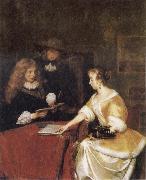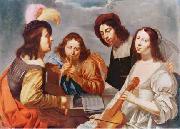Wholesale Oil Painting Reproductions No Minimum and Door to Door! |
|||||||||||
|
|
|||||||||||

|
|||||||||||
|
|
|
||||||||
All TERBORCH, Gerard Oil Paintings |
||||||||
|
|
||||||||
|
|
||||||||
|
Artist Introduction: Dutch Baroque Era Painter, 1617-1681
Dutch genre and portrait painter. He studied with his father and traveled throughout Europe, showing extraordinary precocity in his early work. In 1648 he attended the congress at Menster and painted portraits of the delegates that he incorporated in his celebrated group, The Peace of Menster (National Gall., London). Soon after, he was invited to Spain, where he worked for Philip IV. On returning to Holland in 1650 he painted a variety of genre scenes, capturing the individuality of each subject and portraying the life and customs of the wealthy burgher class with rare dignity and distinction. The tiny portraits and the interiors that were his specialty are painted with elegance, serenity, and a technique of consummate craftsmanship. Among his most famous pictures are Self-Portrait and The Toilet (The Hague), and The Guitar Lesson (National Gall., London). |
||||||||
|
|
||||||||
|
A Concert Painting ID:: 33654 |
mk86
c.1675
Oil on panel
58.1x47.3cm
Cincinnati |
|||||||
Height Width |
INS/CM Quality |
|||||||
|
X |
| |||||||
|
|
||||||||
All Lorenzo Costa Oil Paintings |
||||||||
|
|
||||||||
|
|
||||||||
|
Artist Introduction: 1460-1535
Italian
Lorenzo Costa Locations
Italian painter of the Ferrarese and Bolognese schools. Trained in the manner of such painters as Tura and Cossa, he modified the strident Ferrarese style when he became a partner of Francia. Among his paintings are the Madonna and Child with the Bentivoglio Family and the Triumphs of Petrarch in San Giacomo Maggiore, the Madonna with Saints in San Petronio, and the Madonna in San Giovanni in Monte, all in Bologna. His Three Saints is in the Metropolitan Museum. |
||||||||
|
|
||||||||
|
|
A Concert Painting ID:: 42900 |
mk170
circa 1510
Oil on poplar
95.3x75.6cm
|
||||||
Height Width |
INS/CM Quality |
|||||||
|
X |
| |||||||
|
|
||||||||
All Jan van Bijlert Oil Paintings |
||||||||
|
|
||||||||
|
|
||||||||
|
Artist Introduction: Dutch Baroque Era Painter, ca.1597-1671
Dutch painter. He was the son of the Utrecht glass painter Herman Beerntsz. van Bijlert (c. 1566-before 1615). Jan must have trained first with his father but was later apprenticed to the painter Abraham Bloemaert. After his initial training, he visited France and travelled to Italy, as did other artists from Utrecht. Jan stayed mainly in Rome, where he became a member of the Schildersbent; he returned to Utrecht in 1624. In Rome he and the other Utrecht artists had come under the influence of the work of Caravaggio; after their return home, this group of painters, who became known as the UTRECHT CARAVAGGISTI, adapted the style of Caravaggio to their own local idiom. The Caravaggesque style, evident in van Bijlert's early paintings, such as St Sebastian Tended by Irene (1624; Rohrau, Schloss; see fig.) and The Matchmaker (1626; Brunswick, Herzog Anton Ulrich-Mus.), is characterized by the use of strong chiaroscuro, the cutting off of the picture plane so that the image is seen close-up and by an attempt to achieve a realistic rather than idealized representation. |
||||||||
|
|
||||||||
|
|
A Concert Painting ID:: 97935 |
oil on canvas
Dimensions 103.5 x 144.5 cm
cyf |
||||||
Height Width |
INS/CM Quality |
|||||||
|
X |
| |||||||
|
|
||||||||
|
Prev Next
|
||||||||
|
|
||||||||
|
Related Paintings to Jan van Bijlert :. |
||||||||
|
|
||||||||
|
CONTACT US |



